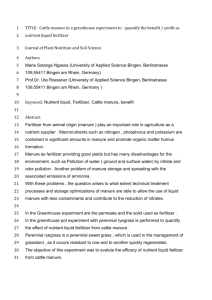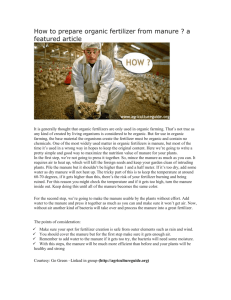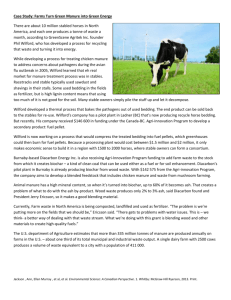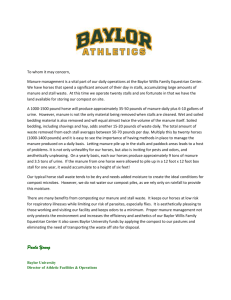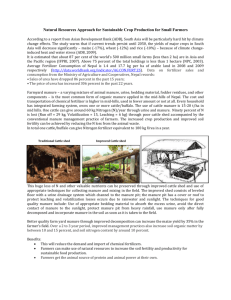Solid Manure Injection Proves Technically Feasible
advertisement
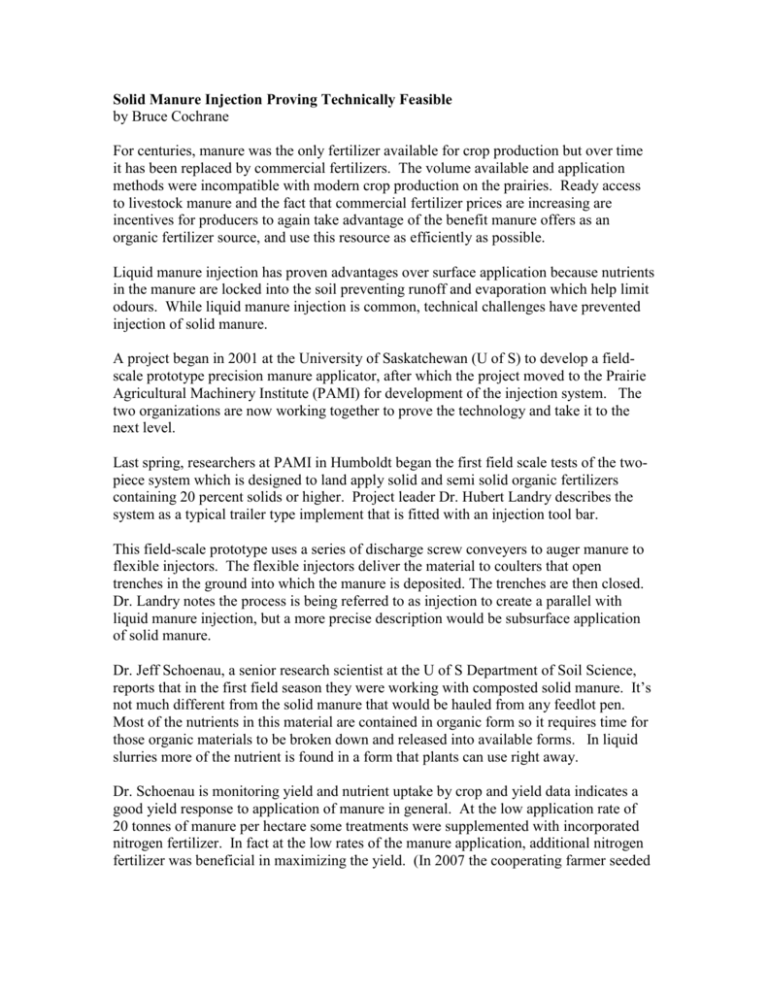
Solid Manure Injection Proving Technically Feasible by Bruce Cochrane For centuries, manure was the only fertilizer available for crop production but over time it has been replaced by commercial fertilizers. The volume available and application methods were incompatible with modern crop production on the prairies. Ready access to livestock manure and the fact that commercial fertilizer prices are increasing are incentives for producers to again take advantage of the benefit manure offers as an organic fertilizer source, and use this resource as efficiently as possible. Liquid manure injection has proven advantages over surface application because nutrients in the manure are locked into the soil preventing runoff and evaporation which help limit odours. While liquid manure injection is common, technical challenges have prevented injection of solid manure. A project began in 2001 at the University of Saskatchewan (U of S) to develop a fieldscale prototype precision manure applicator, after which the project moved to the Prairie Agricultural Machinery Institute (PAMI) for development of the injection system. The two organizations are now working together to prove the technology and take it to the next level. Last spring, researchers at PAMI in Humboldt began the first field scale tests of the twopiece system which is designed to land apply solid and semi solid organic fertilizers containing 20 percent solids or higher. Project leader Dr. Hubert Landry describes the system as a typical trailer type implement that is fitted with an injection tool bar. This field-scale prototype uses a series of discharge screw conveyers to auger manure to flexible injectors. The flexible injectors deliver the material to coulters that open trenches in the ground into which the manure is deposited. The trenches are then closed. Dr. Landry notes the process is being referred to as injection to create a parallel with liquid manure injection, but a more precise description would be subsurface application of solid manure. Dr. Jeff Schoenau, a senior research scientist at the U of S Department of Soil Science, reports that in the first field season they were working with composted solid manure. It’s not much different from the solid manure that would be hauled from any feedlot pen. Most of the nutrients in this material are contained in organic form so it requires time for those organic materials to be broken down and released into available forms. In liquid slurries more of the nutrient is found in a form that plants can use right away. Dr. Schoenau is monitoring yield and nutrient uptake by crop and yield data indicates a good yield response to application of manure in general. At the low application rate of 20 tonnes of manure per hectare some treatments were supplemented with incorporated nitrogen fertilizer. In fact at the low rates of the manure application, additional nitrogen fertilizer was beneficial in maximizing the yield. (In 2007 the cooperating farmer seeded oats, however the equipment is intended to match to any crop system so it doesn’t matter what is seeded on the field that is fertilized.) The study compares three different methods of manure application: broadcast without incorporation; broadcast with incorporation; and solid cattle manure injection. The yield of oats with the injected solid cattle manure plots was not significantly different from the other methods of application. As part of a related study, Joy Agnew, a U of S Agricultural and Bioresource Engineering graduate student, is comparing odour and greenhouse gas emissions in liquid and solid manures with surface and sub-surface applications. The research is intended to determine which is the more emission-friendly type of manure soil application. Whenever possible the solid manure injector prototype at PAMI applied the solid manure with both surface and subsurface applications. For some of the solid treatments, and all of the liquid treatments, manure was hand applied. They simulated as closely as possible actual broadcast liquid manure application and injected liquid manure application, then deployed two types of chambers to capture the emissions on the soil surface after the application to collect greenhouse gas and odour samples. Agnew notes that it makes sense that odours will be reduced when you inject manure under the soil but she wasn’t really sure how the injection was going to affect the greenhouse gas emissions. So it seems that liquid manure will result in more odours and greenhouse gas emissions than solid manure. Liquid manure produces 50 percent higher odours and 80 percent higher greenhouse gases than solid manure. As for the injection versus the surface application, we saw that overall odour emission was decreased by 20 percent due to injection. Injection of solid manure reduced odours a little bit more consistently and provided an overall reduction of odours of 40 percent. The manure application comparisons at Humboldt are scheduled to continue for three years. In addition to providing an opportunity to refine the technology, it will allow an opportunity to look at the effects on other crops. Dr. Schoenau indicates that one of the potential benefits of getting that solid manure below the surface is reducing some of the accumulation of nutrients right at the surface of the soil where they may be susceptible to movement into water bodies by surface runoff waters. This is a particular concern for phosphorus and nitrogen. From a technical point of view, PAMI says the technology is very close to being ready to move to commercialization, however, the first step is to prove its benefits. It needs to be demonstrated that this new machine can bring benefits to farmers in terms of better yields and better environmental results in for greenhouse gas emissions and odours. As the U of S and PAMI work with this equipment, they will continue to refine the functioning to perform more effectively in the field with a variety of different manure sources and under different conditions. They also hope to establish the potential benefits that could come from this technology such as improving the crop utilization of manure nutrients to reduce the loss of nutrients and other constituents to the environment. Sources: Dr. Jeff Schoenau, Ph.D., Senior Research Scientist, Department of Soil Science, College of Agriculture and Bioresources, University of Saskatchewan, Saskatchewan Agriculture and Food Research Chair in Nutrient Management. Dr. Hubert Landry, Project Leader, Technical Services, Prairie Agricultural Machinery Institute Joy Agnew, Graduate Student, College of Agriculture and Bioresources, University of Saskatchewan Bruce Cochrane is host and reporter for the Farmscape daily radio program and Wonderworks Canada Inc., a multi-media news and information content provider. Farmscape is sponsored by Sask Pork and Manitoba Pork Council.


